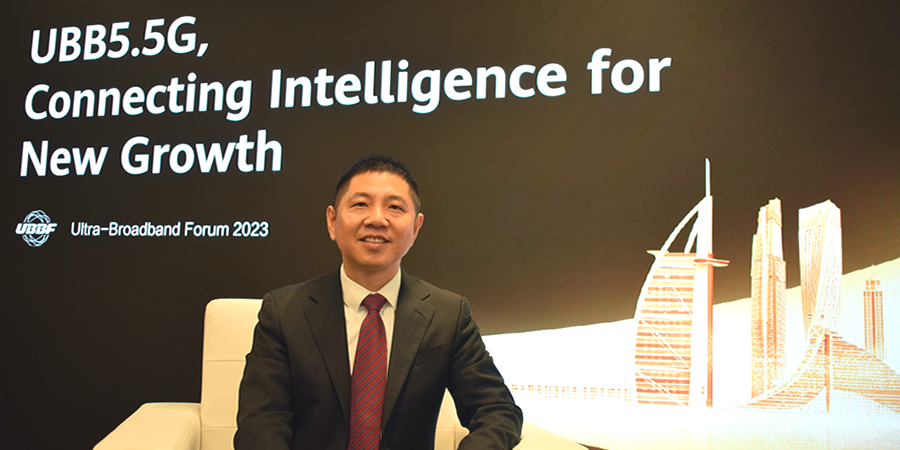In an exclusive interview, Telecom Review had the opportunity to discuss with Leon Wang, President of Huawei Data Communication Product Line, the landscape of ultra-broadband applications, the key characteristics of Net5.5G, its impact on data communication for 2030, and much more.
The Evolving Landscape of Ultra-Broadband Applications
When discussing the new directions and progress in ultra-broadband applications, Wang mentioned that consumers desire the best possible home broadband experience. Innovation in next-generation immersive applications is transitioning from early trial use to mature commercial deployment. He cited a recent example from the Asian Games, where glasses-free 3D and virtual reality technologies were used for live streaming tests. Augmented reality (AR), was also implemented in enterprise digital design and simulation. These next-generation applications place higher demands on home broadband, mobile broadband, and enterprise networks, creating a new wave of growth opportunities
Net5.5G is Transforming Data Communication for 2030
Discussing the latest developments in the Net5.5G industry, Leon Wang highlighted the white paper titled "Research on Trends in Data Communication Networks for 2030," produced by Omdia in partnership with industry stakeholders. This paper, released in 2022, introduced the concept of the Net5.5G target network for the first time, sparking related discussions.
"We believe that Net5.5G will facilitate the upgrade of home broadband, mobile broadband, enterprise networks and enterprise private lines to 10 Gbps ultra-broadband connections. It will drive the adoption of next-generation immersive terminals and applications, enhancing work efficiency and video conferencing experiences. Net5.5G will also support flexible elastic private line services and intelligent computing cloud services to facilitate enterprise digital transformation and intelligent upgrading," he explained.
Furthermore, Wang mentioned that the WBBA has officially established a network technology workgroup to explore key Net5.5G scenarios. He also noted that IEEE and IETF have initiated work on essential technical standardization related to Net5.5G, including Wi-Fi 7, 800GE, and SRv6.
Huawei's Vision for UBB Business Success
Huawei has its unique perspective on achieving success in the ultra-broadband business. To this end, Wang discussed the collaborative promotion of Net5.5G, F5.5G, and 5.5G, which ensures a 10 Gbps digital service experience and supports next-generation immersive services and applications, such as glasses-free 3D and virtual reality. This improvement enhances the average revenue per user (ARPU) for home broadband and mobile broadband while also stimulating new growth.
Within Net5.5G campus networks, the latest Wi-Fi 7 technology is employed to achieve 10 Gbps bandwidth, along with technologies that ensure seamless video conferences with no interruptions, as highlighted by Wang. Many enterprise IT departments require high-quality managed LAN services from carriers, which presents carriers with new opportunities to offer such services.
On the other hand, AI is making its way into various industries, and the demand for ultra-large computing clusters for training foundational models is growing. However, it is impractical for every enterprise to build such clusters. Furthermore, Leon Wang observed that an intelligent society necessitates intelligent computing services and elastic private line services with speeds of 10 Gbps or even higher, enabling numerous industries to harness the benefits of AI technologies. He believes that carriers possess inherent advantages in delivering end-to-end assurance of network and computing services, and Huawei is expecting to achieve new revenue growth in computing services and elastic private line services.
Key Characteristics of the Net5.5G Target Network
To harness the growth opportunities presented by new applications and services, Leon Wang explained that carriers must make appropriate preparations, and networks require continuous upgrades to enhance digital productivity for users and increase revenue for carriers.
For him, in the future, network support holds numerous implications and necessitates a digital map to manage the end-to-end network while ensuring visibility and optimization for the entire network.
“We believe that Net5.5G will facilitate the upgrade of home broadband, mobile broadband, enterprise networks and enterprise private lines to 10 Gbps ultra-broadband connections. It will drive the adoption of next-generation immersive terminals and applications, enhancing work efficiency and video conferencing experiences. Moreover, Net5.5G will introduce new capabilities such as flexible and elastic private line services and a real-time network digital map,” Wang mentioned.
He added that the backbone networks will also evolve into a 400GE and 800GE converged transport network, capable of carrying 2H, 2C and 2B services, thereby reducing network construction costs.
Huawei’s Progress in Developing Net5.5G-Oriented Products and Solutions
Huawei is actively developing a comprehensive range of end-to-end products and solutions to enable carriers to seize new opportunities. In this regard, Leon Wang shared Huawei's plans to release a series of products and solutions for Net5.5G in 2024.
"At Huawei, we recognize that this is a significant trend for both our company and our carrier customers. We are currently in the process of developing our latest solutions and products for Net5.5G. If our customers wish to build Net5.5G infrastructure, we can provide them with a tailored solution. These solutions and products are set to be released at the beginning of the next year," Wang concluded.
Watch the video interview here











